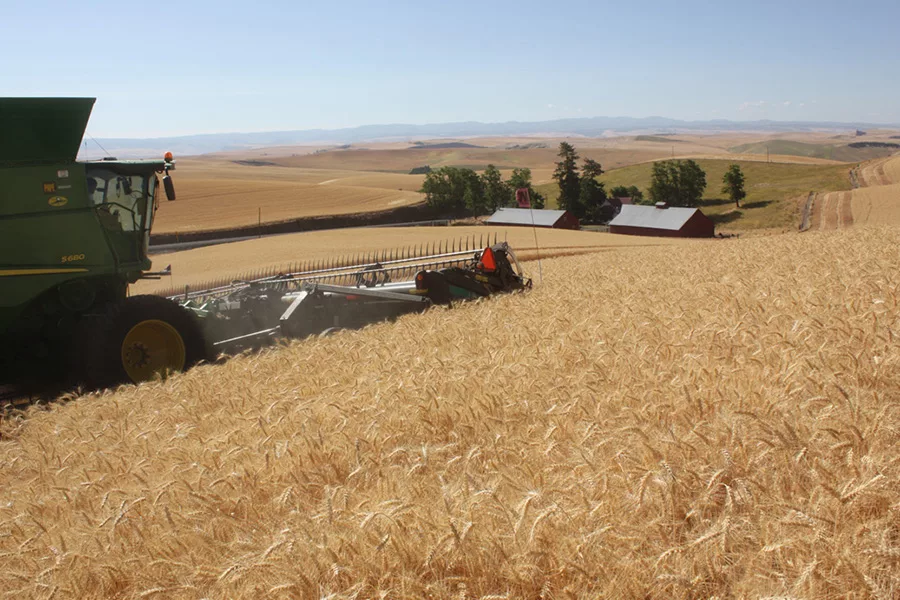
Home » Wheat growers poised to deliver a solid crop despite turmoil
Waves of grain
Wheat growers poised to deliver a solid crop despite turmoil

A combine harvests wheat in Eastern Washington.
Courtesy Wheat LifeJune 12, 2025
Washington’s wheat production in 2025 is expected to benefit from increased acreage and favorable growing conditions, though market factors and export dynamics continue to be unpredictable.
Ranked fourth in the nation for wheat production and third among the commodities grown in the state, Washington wheat was valued at more than $1.7 billion in 2023, the most recent numbers available.
A top export
Washington is one of the nation’s leading wheat-exporting states with 85% to 90% of its production exported each year.
Soft white wheat sales in 2024-25 were up 44% compared to the previous period. As of May 1, soft white sales reached their highest since 2020-21, totaling 5.73 million metric tons, or 210.5 million bushels.
Competitive prices throughout the marketing year boosted sales, with top international markets outside the U.S. continuing to be South Korea, Philippines, Japan, Indonesia and Thailand, which use soft white wheat in many staples of their cultural cuisine, said Casey Chumrau, CEO of the Washington Grain Commission (WGC).
This year, the industry faces a new challenge: tariffs.
“Exports are crucial for the industry, with nearly 50% of all U.S. wheat production being exported. For Washington wheat farmers, overseas demand is even more critical, as over 90% of our wheat is exported,” said Michelle Hennings, executive director of the Washington Association of Wheat Growers.
Washington exported $651.8 million in wheat in 2024.
“We have yet to see many direct impacts to wheat exports due to the tariffs because reciprocal tariffs imposed by the countries of our customers will be the determining factor, and wheat has largely avoided those reciprocal tariff lists. Wheat is far less dependent on China than other Washington commodities,” Hennings said.
Regardless of how tariffs might affect sales, Hennings said that they will increase the cost of inputs, which can include seeds, fertilizer, pesticides and machinery.
“With grain prices already below break-even, this will be a significant challenge to farmers across the state. Many of the inputs used to grow wheat and barley are sourced from overseas, and any cost increase will be passed through to the farmer, who does not have the ability to pass cost increases on,” she said.
Chumrau said Washington growers will continue to focus on reliably producing the highest quality wheat possible.
“Washington will never be a low-cost supplier,” she said.
Despite tariffs and other shifts in global relations, Chumrau said WGC is already scheduled to host seven international trade teams this summer and visit customers in at least seven countries before year’s end.
Increased yields
The state’s wheat industry continues to recover from a record low crop in 2021, charting substantially increased yields in 2024 of 27% for a total crop of 143.6 million bushels, or 3.9 million metric tons.
Most notably, 2024 winter wheat yields increased 30% over the previous year to 70 bushels per acre, exceeding the five-year average of 62 bushels per acre. Spring wheat saw a 13% increase year-over-year to 43 bushels per acre, falling just below the five-year average of 44 bushels per acre.
Soft white wheat accounted for 89% of Washington’s 2023-24 production, followed by hard red winter at 7% and hard red spring at 4% of the total.
Washington barley production in 2024 increased 3.8% compared to previous year, reaching 4.62 million bushels.
“Planting conditions for winter wheat in 2023 for harvest in 2024 significantly improved from the prior year with sufficient moisture aiding crop establishment in most regions. The mild winter and mild spring temperatures supported growth after the plants emerged from winter dormancy,” Chumrau said.
Despite lower-than-average spring precipitation, timely rain and cool temperatures through the end of May 2025 provided favorable conditions for spring wheat planting and overall crop development of both winter and spring wheat.
Chumrau said extreme heat in June 2024 stressed spring-planted fields and affected yields compared to that of the more mature winter-planted fields.
The forecast is tracking positively for the 2024-25 crop, with 78% of the state’s wheat cropis rated “good to excellent,” according to the National Agricultural Statistics Service, which Chumrau said is a notable increase from 56% receiving that grade at the same time last year.
Economic challenges
Inflation, high input costs and a drop in commodity prices have posed significant challenges to wheat farmers in recent years, Hennings said.
“The USDA’s 2024 net cash farm income for U.S. agriculture is projected to be 27% lower than in 2022,” she said. “The U.S. agricultural trade deficit is projected at a record $42.5 billion in fiscal year 2025,” and “farm sector debt for 2024 is projected to reach an all-time high (inflation-adjusted) level.”
Hennings said that wheat prices are hovering at 2019 levels, averaging $1.50 to $2 per bushel below the cost of production.
In the meantime, $30 billion in federal disaster recovery assistance is available for farmers and livestock producers through the Emergency Commodity Assistance Program. Sign-ups end Aug. 15.
“Most farmers I have spoken with have applied and already received payment which couldn’t have been better timing,” Hennings said. “It is just a Band-Aid but it does provide some relief to farmers to help get by. Over $7 billion in payments have been paid out to date.”
There also will be a Supplemental Disaster Relief Program to provide assistance to producers for necessary expenses due to losses of revenue, quality or production of crops due to weather-related events in 2023-24, including those with uncovered losses.
The state also has addressed the issue of farmers not being able to receive exemption from added fuel costs under the state’s Climate Commitment Act.
Rebates were previously provided while the state worked out a solution. Now, farmers can purchase exempt fuel through a distributor and the recently passed House Bill 1912 will provide more education to farmers on where they can buy exempt fuel, Hennings said.
Agriculture + Viticulture
KEYWORDS June 2025
Related Articles
Related Products





